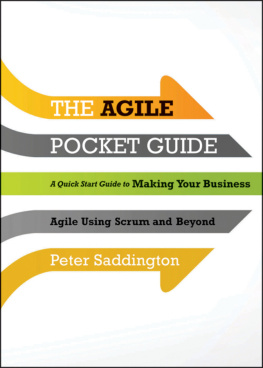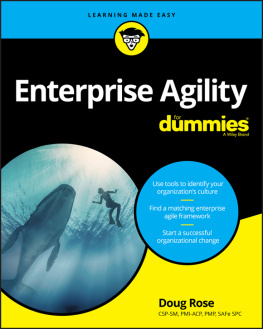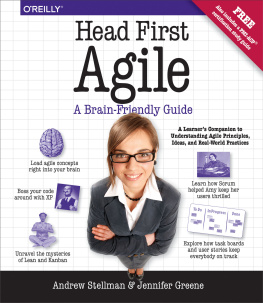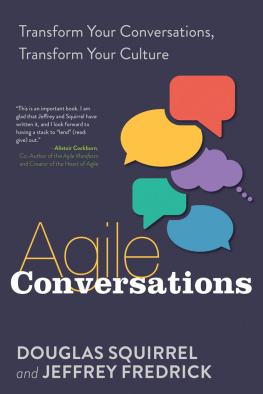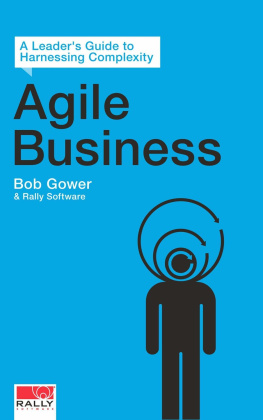About This eBook
ePUB is an open, industry-standard format for eBooks. However, support of ePUB and its many features varies across reading devices and applications. Use your device or app settings to customize the presentation to your liking. Settings that you can customize often include font, font size, single or double column, landscape or portrait mode, and figures that you can click or tap to enlarge. For additional information about the settings and features on your reading device or app, visit the device manufacturers Web site.
Many titles include programming code or configuration examples. To optimize the presentation of these elements, view the eBook in single-column, landscape mode and adjust the font size to the smallest setting. In addition to presenting code and configurations in the reflowable text format, we have included images of the code that mimic the presentation found in the print book; therefore, where the reflowable format may compromise the presentation of the code listing, you will see a Click here to view code image link. Click the link to view the print-fidelity code image. To return to the previous page viewed, click the Back button on your device or app.
THE AGILE CULTURE
LEADING THROUGH TRUST AND OWNERSHIP
Pollyanna Pixton
Paul Gibson
Niel Nickolaisen

Upper Saddle River, NJ Boston Indianapolis San Francisco
New York Toronto Montreal London Munich Paris Madrid
Capetown Sydney Tokyo Singapore Mexico City
Many of the designations used by manufacturers and sellers to distinguish their products are claimed as trademarks. Where those designations appear in this book, and the publisher was aware of a trademark claim, the designations have been printed with initial capital letters or in all capitals.
The authors and publisher have taken care in the preparation of this book, but make no expressed or implied warranty of any kind and assume no responsibility for errors or omissions. No liability is assumed for incidental or consequential damages in connection with or arising out of the use of the information or programs contained herein.
For information about buying this title in bulk quantities, or for special sales opportunities (which may include electronic versions; custom cover designs; and content particular to your business, training goals, marketing focus, or branding interests), please contact our corporate sales department at or (800) 382-3419.
For government sales inquiries, please contact .
For questions about sales outside the U.S., please contact .
Visit us on the Web: informit.com/aw
Cataloging-in-Publication Data is on file with the Library of Congress.
Copyright 2014 Pearson Education, Inc.
All rights reserved. Printed in the United States of America. This publication is protected by copyright, and permission must be obtained from the publisher prior to any prohibited reproduction, storage in a retrieval system, or transmission in any form or by any means, electronic, mechanical, photocopying, recording, or likewise. To obtain permission to use material from this work, please submit a written request to Pearson Education, Inc., Permissions Department, One Lake Street, Upper Saddle River, New Jersey 07458, or you may fax your request to (201) 236-3290.
ISBN-13: 978-0-321-94014-8
ISBN-10: 0-321-94014-8
Text printed in the United States on recycled paper at RR Donnelley in Crawfordsville, Indiana.
First printing, February 2014
Praise for The Agile Culture
This is the Agile book Ive been waiting for. Enough with the rituals of process. Lets get into what really matterscreating the culture that teams need to thrive.
Marty Cagan, founding partner, The Silicon Valley Product Group
A book full of practical tools and real-life storiesa great resource for every leader involved in a serious Agile transformation.
Hendrik Esser, director of portfolio and technology management, Ericsson
What is culture? How do we create a culture? What are our cultural problems? These questions can have lofty, philosophical, theoretical answers that sound profound. Unfortunately, profundity rarely gets the job done. The authors have once again broken an important topic into easily understood parts. Not only do they make the questions understandable, they provide specific, actionable techniques for answering the questions and addressing the challenges. This book is as much a how-to as it is a what-is-it and a why-do-I-care book. Everybody who is in a leadership role, or deals with people in leadership roles (thatd be just about everyone, right?) should read this.
Steven Doc List, vice president of learning, Santeon Group
The content is phenomenal! Just an incredible distillation of years of experience.
Christine DelPrete, senior director of technology, Amirsys, Inc.
To my mother, an amazing woman. And to the McKinney family, who
have taken me in as one of their own.
Pollyanna Pixton
I dedicate this book to my wife, Carrie, who has been my companion, my
help, and my support for the last forty years and without whom none of
this would have been possible.
Paul Gibson
This is dedicated to my family and friendsthe people who have helped
me have a wonderful life.
Niel Nickolaisen
Foreword
Its all about the people...
Change, or any transformation activity, is daunting. As experts tell us, You dont change people, you can only change the process. So how do we, as leaders, motivate and inspire our employees and organizations to change?
Command and control leadership limits creativity, broad thinking, and the ability for us, as leaders, to get the most out of the talent in the organization. The Millennials that we hire today are very social, and they interact and learn through social means in a very virtual and boundaryless hierarchy. Large organizations, by their very own weight, are not nimble. But in todays social/cloud/mobile world, organizations need to experiment and pivot more rapidly. To compound this dilemma, process tends to govern too tightly, with every exception or edge case being overmanaged. Process becomes a controlling means to an end and not a guideline. Organizational outcomes tend to be measured in vanity metrics. Trust is completely eroded, and creativity is muffled.
Dealing with this requires a shift in our leadership model: a move from command and control to a collaborative model that builds trust and pushes ownership and decision making deeper into the organization, while retaining a good balance of process and policy. The outcomes demonstrate an organization with energy and creativity, surfacing the talent and resilience to innovate and pivot as the business dictates.
I like this book, and the authors, because these ideas have been applied successfully with groups within IBM and within elements of Pitney Bowes. With the help of many employees who piloted the initial workshops, the authors polished many of the early models and refined them to the point where they were able to publish them for this book. Additionally, the authors provide metrics that can help you know whether you are on the right path to building a high-performing, collaborative team and creating a culture of trust.
Now, what do I have to say about the authors and why I admire them for writing this book? Paul Gibson and I worked together from 2007 to 2010 at IBM. He is truly a proper British gentleman. He helped me with the Agile adoption initiativeduring which we trained, in 18 months, more than 8,000 employees on Agile approachesresulting in over 60 percent of projects using Agile. The success of the Agile adoption is directly correlated to his passion and commitment to the IBMers and their wanting to get off the dreaded six-month project death marches. As we rolled out Agile at IBM, it highlighted the need for better communication and collaboration. This is how I met Pollyanna Pixton and Niel Nickolaisen.


